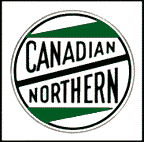Canadian Northern Railway
 |
|
| Locale | Canada |
|---|---|
| Dates of operation | 1899–1923 |
| Track gauge | 4 ft 8 1⁄2 in (1,435 mm) standard gauge |
| Headquarters | Toronto, Ontario |
The Canadian Northern Railway (CNoR) is a historic Canadian transcontinental railway. At its demise in 1923, when it was merged into the Canadian National Railway (reporting mark CN), the CNoR owned a main line between Quebec City and Vancouver via Ottawa, Winnipeg, and Edmonton.
CNoR had its start in the independent branchlines that were being constructed in Manitoba in the 1880s and 1890s as a response to the monopoly exercised by Canadian Pacific Railway (CPR). Many of these branchlines were built with the sponsorship of the provincial government, which sought to subsidize local competition to the federally subsidized CPR; however, significant competition was also provided by the encroaching Northern Pacific Railway (NPR) from the south.
Two of these branchline contractors, Sir William Mackenzie and Sir Donald Mann, took control of the bankrupt Lake Manitoba Railway and Canal Company in January, 1896. Mackenzie and Mann expanded their enterprise, in 1897, by building further north into Manitoba's Interlake district as well as east and west of Winnipeg. They also began building and buying lines south to connect the U.S. border at Pembina, North Dakota, and east to Ontario.
The Canadian Northern Railway was established, in 1899, and all railway companies owned by Mackenzie and Mann (primarily in Manitoba) were consolidated into the new entity. CNoR's first step toward competing directly with CPR came at the start of the 20th century with the decision to build a line linking the Prairie Provinces with Lake Superior at the harbour in Port Arthur-Fort William (modern Thunder Bay, Ontario) which would permit the shipping of western grain to European markets as well as the transport of eastern Canadian goods to the West. This line incorporated an existing CNoR line to Lake of the Woods and two local Ontario railways, the Port Arthur, Duluth and Western Railway and the Ontario and Rainy River Railway whose charters Mackenzie and Mann had acquired in 1897. To reach Port Arthur which became the lake terminus of the CNoR, the line extended south of Lake of the Woods into northern Minnesota before heading northeast through Rainy River District to the head of navigation on the Great Lakes. The Winnipeg-Port Arthur line was completed on December 30, 1901 with the last spike being driven just east of Atikokan station by Ontario's Commissioner of Crown Lands, Elihu Davis.
...
Wikipedia
